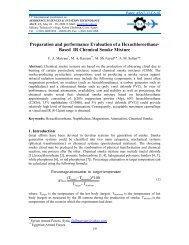Finite Element Modeling of Crushing Behaviour of Thin Tubes with ...
Finite Element Modeling of Crushing Behaviour of Thin Tubes with ...
Finite Element Modeling of Crushing Behaviour of Thin Tubes with ...
You also want an ePaper? Increase the reach of your titles
YUMPU automatically turns print PDFs into web optimized ePapers that Google loves.
9/19<br />
Paper: ASAT-13-ST-34<br />
file. A list <strong>of</strong> numerical values <strong>of</strong> the basic material properties required for the tube models is<br />
given in Fig. (2). All the tube models used in the present finite element simulation were<br />
generated by using the element S4R. This element is a three-dimensional doubly curved fournode<br />
shell element. Each node has three-displacement and three-rotation degrees <strong>of</strong> freedom.<br />
Moreover, this element is considered a general-purpose shell element where it allows for large<br />
strains as load increases. In order to predict the overall response accurately, the mesh <strong>of</strong> finite<br />
elements was fine and uniform <strong>with</strong> equal number <strong>of</strong> elements along the length <strong>of</strong> the tube<br />
and through its circumferential direction. On the other side, all the tube models were crushed<br />
axially between upper and lower rigid parallel plates. These two parallel plates were<br />
simulated by using three-dimensional four-node rigid elements R3D4. The tubes were crushed<br />
by pushing down the upper rigid plate. The latter was fixed in all degrees <strong>of</strong> freedom except<br />
the vertical downward displacement where the loading was applied. However, the lower rigid<br />
plate was stationary by constraining its whole degrees <strong>of</strong> freedom. All tube models rested free<br />
on the lower rigid plate however the applied force was attained as a reaction created from the<br />
pushing <strong>of</strong> the upper plate. The quasi-static loading condition was achieved by moving the<br />
upper plate slowly downward over a sufficiently long time. It is noted that the tubes were not<br />
completely free due to the effect <strong>of</strong> friction between the tube models and the crushing parallel<br />
plates. The progressive deformation shape was continuously monitored for each tube and the<br />
corresponding force-axial displacement curve was depicted.<br />
Experimental Validation<br />
The validation <strong>of</strong> the finite element tube model was made by direct comparison <strong>with</strong> the<br />
experimental results and the collapse observations <strong>of</strong> the square tube US-2 subjected to quasistatic<br />
axial compression and examined by Paik et al. [1]. The structural geometry <strong>of</strong> the<br />
specimen and the properties <strong>of</strong> the used material are shown in Fig. (2). All other testing<br />
details used in the experimental works were necessarily simulated in finite element model.<br />
The progressive collapse <strong>of</strong> the finite element tube model and the examined specimen at<br />
various stages <strong>of</strong> the compression are compared in Fig. (3). Visual examination <strong>of</strong> the pictures<br />
showed good agreements between the numerical simulations and the experimental outcomes.<br />
Comparing the predicted load-displacement behaviour <strong>with</strong> the experimental results in [1] and<br />
the obtained calculations in [2] revealed good correlation between curves at the same<br />
displacement values as shown in Fig. (4).<br />
Table (1) lists the comparison <strong>of</strong> results between the previously published work and the<br />
present finite element analysis.<br />
Investigation <strong>of</strong> <strong>Crushing</strong> <strong>Behaviour</strong><br />
The present numerical simulation provides an opportunity to predict the fold formation <strong>of</strong><br />
various tubes. Figures (5-10) display the collapse mechanisms accompanied by the<br />
corresponding axial- and energy-displacement curves <strong>of</strong> different tube models. Folding modes<br />
were symmetric about the principal axes <strong>of</strong> all the tubes cross-sections. Moreover, an axisymmetric<br />
mode was noticed during the deformation <strong>of</strong> the circular tube. The entire tube<br />
models initiated folding from the top end in contact <strong>with</strong> the movable upper plate. However,<br />
the circular tube began to fold from the bottom end in contact <strong>with</strong> the fixed lower plate. It is<br />
worth mentioning that, the folding process <strong>of</strong> polygonal tubes was initiated by random interior<br />
and exterior rotating <strong>of</strong> the upper edges <strong>of</strong> sidewalls. <strong>Tubes</strong> <strong>of</strong> square and hexagonal crosssections<br />
created symmetric inward and outward folds on each two opposite sidewalls. Folds<br />
<strong>of</strong> the triangular tube initiated by curving its upper edges completely inward. However, the





